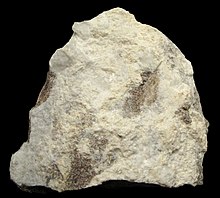Portlandite
| Portlandite | |
|---|---|
 Portlandite andettringite | |
| General | |
| Category | Oxide mineral |
| Formula (repeating unit) | Ca(OH)2 |
| IMA symbol | Por[1] |
| Strunz classification | 4.FE.05 |
| Dana classification | 06.02.01.04 Brucite group |
| Crystal system | Trigonal |
| Crystal class | Hexagonal scalenohedral (3m) H-M symbol:(32/m) |
| Space group | P3m1 |
| Unit cell | a = 3.589 Å, c = 4.911 Å; Z = 1 |
| Identification | |
| Color | Colorless, white to greenish white |
| Crystal habit | Hexagonal plates; commonly fibrous, powdery, massive. |
| Cleavage | Perfect on {0001} |
| Tenacity | Sectile with flexible cleavage plates |
| Mohs scalehardness | 2 |
| Luster | Pearly on cleavages |
| Diaphaneity | Transparent |
| Specific gravity | 2.23 |
| Optical properties | Uniaxial (−) |
| Refractive index | nω= 1.574 nε= 1.547 |
| Birefringence | δ = 0.027 |
| Solubility | Soluble in water producing an alkaline solution |
| Alters to | Alters to CaCO3on exposure to CO2bearing waters |
| References | [2][3][4][5][6] |
Portlanditeis ahydroxide-bearing mineral typically included in theoxide mineralclass. It is the naturally occurring form ofcalcium hydroxide(Ca(OH)2) and the calcium analogue ofbrucite(Mg(OH)2).
Occurrence
[edit]Portlandite occurs in a variety of environments. At thetype locationin Northern Ireland it occurs as an alteration ofcalc–silicate rocksbycontact metamorphismoflarnite–spurrite.It occurs asfumaroledeposits in theVesuviusarea. In Jebel Awq,Oman,it occurs as precipitates from analkalinespringemanating fromultramaficbedrock. In theChelyabinskcoal basin ofRussiait is produced by combustion ofcoalseams and similarly by spontaneous combustion ofbitumenin the Hatrurim Formation of theNegev desertinIsraeland the Maqarin area,Jordan.[3]It also occurs in themanganesemining area ofKuruman,Cape Province,South Africain theKalahari Desertwhere it occurs as large crystals and masses.[4][3]
It occurs in association withafwillite,calcite,larnite,spurrite,halite,brownmillerite,hydrocalumite,mayeniteandettringite.[3]
It was first described in 1933 for an occurrence atScawt Hill,Larne,County Antrim,Northern Ireland.It was named portlandite because the chemical calcium hydroxide is a common hydrolysis product ofPortland cement.[4][3]
References
[edit]- ^Warr, L.N. (2021)."IMA–CNMNC approved mineral symbols".Mineralogical Magazine.85(3): 291–320.Bibcode:2021MinM...85..291W.doi:10.1180/mgm.2021.43.S2CID235729616.
- ^"Mineralienatlas - Fossilienatlas".www.mineralienatlas.de.
- ^abcde"Handbook of Mineralogy"(PDF).
- ^abc"Portlandite: Mineral information, data and localities".www.mindat.org.
- ^"Portlandite Mineral Data".www.webmineral.com.
- ^Pallache, Charles;Berman, Harry; Frondel, Clifford (1944).The System of Mineralogy of James Dwight Dana and Edward Salisbury Dana(7 ed.). Wiley. pp. 641–642.ISBN9780471192398.
